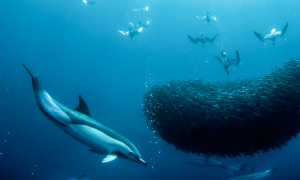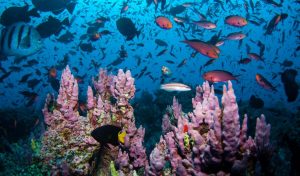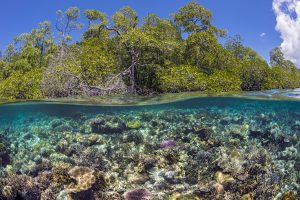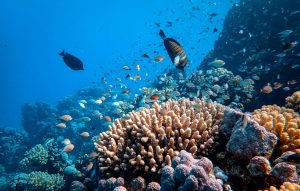The ocean is fundamental to the functioning of all life on earth — chemically, physically, biologically and economically. To protect it is essential; and that protection must somehow be financed.
With only 7 per cent of the global ocean currently protected at all, and only 2.7 per cent under high protection, initiatives such as the United Nation’s ‘30 by 30’ (protecting 30 per cent of the ocean by 2030) seem high on ambition but a stretch to achieve.
To take more meaningful steps in the conservation and restoration of marine life, a variety of financing mechanisms are emerging. After all, what better way to convince investors to finance ocean conservation than by highlighting what they get in return?

Here we look at a range of large-scale funding mechanisms that illustrate how even entire governments can be moved to spend money on ocean conservation. They include:
- conservation trust funds.
- insurance incentives.
- ‘blue bonds’ and debt-for-nature swaps.
Though some can also work at a more local scale, they often cover large areas of ocean, and even entire exclusive economic zones (EEZs).
Conservation trust funds
One of the more established streams of funding for both terrestrial and marine conservation has come in the form of conservation trust funds (CTFs), which use grant money to provide projects with long-term capital. There are three main types:
- Endowment funds: A sum of money is invested, and the interest, or interest plus capital growth, generated is available to spend.
- Sinking Funds: A sum of money is provided, a proportion of which is spent annually until it ‘sinks’ to zero.
- Revolving Funds: A sum of money is invested into a fund and replenished through fees, taxes or levies, and the revenues may be disbursed or set aside to create an endowment.
Between 2009 and 2018 more than USD 2 billion was paid out from various CTFs to support conservation projects around the world.
There are more than 108 active CTFs that provide funds for marine and coastal ecosystem protection. One of these is the Ascension Island Marine Protected Area trust (AIMPACT), established by Blue Marine in support of the MPA in the waters surrounding the UK territory in the South Atlantic.
In 2019, Ascension Island designated 100 per cent of its waters as a marine protected area, creating what was at the time the largest such reserve in the Atlantic. It covers 440,000 square kilometres and is 99.5 per cent ‘no-take’, meaning no fishing at all is permitted.

In recognition of the commitment in perpetuity made by Ascension for global biodiversity, Blue Marine established the £2-million AIMPACT endowment fund to generate an annual return of around 4-to-5 per cent, or £80k-100k per year — equivalent to the amount generated by the sale of fishing licences to the long-line fleet that previously operated in Ascension’s waters. The annual return generated by the AIMPACT fund is intended to fund projects on island that support community, heritage, environment and education.
Because CTFs rely on their investments and the global economy there can be limitations in ensuring the target return rates. They also rely almost completely on initial philanthropic donations, which can be difficult to find in large amounts. Donors are often reluctant to see capital locked up rather than paid out immediately to high-impact projects. But Ascension was a special case, being a military island, with no way of drawing in money through tourism or other fees. Generally though, more and more CTFs are being established using tourism and licence fees to build up assets, which reduces their dependence on donations.
Insurance incentives
Around the world, coastal ecosystems provide nearly USD 52 billion in savings to insurance companies through protection from storms, coastal flooding, and coastal erosion — yet this contribution often goes unnoticed. So another financing mechanism uses insurance to provide capital to coastal ecosystems when they need it most.
In recognition of the exceptional benefits provided by these ecosystems, in 2017 the government of Quintana Roo state in Mexico bought a unique USD 3.8 million insurance policy that covers 160 km of its coastline. The policy was paid for using tourism tax revenues, and has a separate fund as its beneficiary that may only use the pay-out money for the restoration and rehabilitation of the reef and ecosystems on the nearby coast.
In December 2020 the first pay-out occurred, with USD 800,000 going toward restoring the coral reef after destruction due to Hurricane Delta. With climate-related hazards only growing in number, this kind of mechanism allows for sustained protection and restoration of key coastal ecosystems.

‘Blue bonds’ and debt-for-nature swaps
High levels of debt in developing nations often leave them unable to fund environmental conservation. To tackle issues like this at national level, ‘blue bonds’ and debt-for-nature swaps have been developed. These aim to lower or restructure sovereign debt, allowing countries to pay for the protection of their environment. The concept mostly applies to highly indebted tropical countries with valuable natural capital.
Both mechanisms are large-scale transactions, often involving a country in severe foreign debt, a conservation NGO and a creditor (usually a commercial bank or foreign government).
In the case of traditional bonds, bond issuers borrow money from an investor with an agreed date of repayment and annual interest payments.
In the case of a ‘blue bond’, issuance proceeds are committed to — and funds for repayment are generated from — investments into ocean-related conservation or commercial projects.
Debt-for-nature swaps are an extension of this concept, first used in 1987 and also aimed at indebted countries with difficulties funding conservation. In these transactions, NGOs, or occasionally governments, buy sovereign debt from banks and transfer the debt back to the issuer countries in exchange for conservation commitments.
The world’s largest debt-restructuring for marine conservation to date is the Belize Blue Bond. With its coral reefs alone generating more than USD 80 million in annual revenues, Belize is a nation highly dependent on its coastal ecosystems. Since it was heavily in debt, the Nature Conservancy (TNC) and Credit Suisse arranged the sale and purchase of ‘blue bonds’, raising USD 364 million. This was used to:
- partly repay old debt (USD 546 million at a 45 per cent discount).
- establish an endowment fund (~ USD 24 million) for marine conservation.
- set up a new conservation fund (~ USD 80 million to be used over 20 years).
An estimated USD 180 million was unlocked to support Belize’s commitment to protect 30 per cent of its ocean, strengthen governance and improve regulations for coastal blue carbon projects.

One of the most recognised debt-for-nature swaps focused on marine life in the Seychelles. In 2016, the Seychelles (with TNC) raised USD 21 million in impact capital and grants to buy and refinance its sovereign debt under more favourable terms. The deal should ensure that 400,000 km2 will be managed as MPAs within five years — and the strategy seems to be working: by March 2020, Seychelles had made every debt-related payment on time and completed the protection of 32 per cent of its waters.
These fiscal mechanisms illustrate the diverse ways in which good practice and protection can be incentivised and financed. There are concerns about the adverse effects that protected areas will have on coastal developing states due to fishing closures, but a recent publication in Nature overturns that contention. The study claims that if 30 per cent of the ocean was protected, annual global catch of fish could increase by 8 million tonnes through allowed fish stock recovery.
Without healthy oceans it is impossible to sustain the food supply, tourism, and coastal protection that are vital to many people, particularly in developing states. The next two blogs will focus on funding at a more local and small-scale level, covering incentivised financing through payments for ecosystem services and more novel approaches using carbon, nitrate, and biodiversity credits.



















